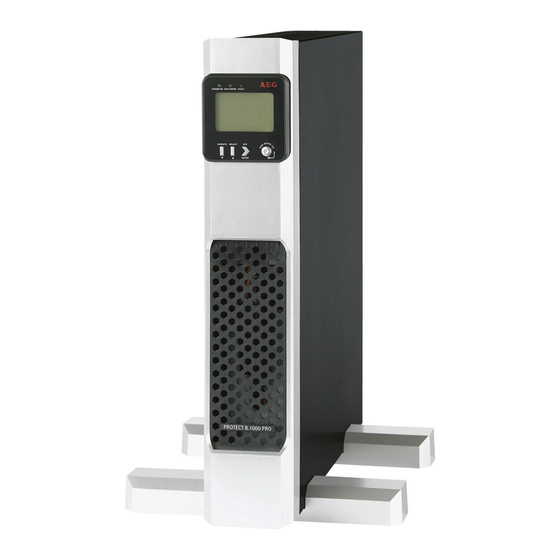
Summarization of Contents
Notes on Operating Instructions
Duty to Provide Information
Explains the purpose and design of these operating instructions and the importance of safety.
Validity and Liability
Covers the manual's compliance with current specifications and warranty liability.
Handling Precautions
Provides guidelines for safe handling and maintenance by qualified personnel.
Customer Support
Information on contacting the hotline for technical assistance and support.
Copyright Notice
Details the copyright information and rights reserved for the operating instructions.
General Information
Brief Overview
Provides a general overview of the UPS features, front and back panel functions.
System Description
Explains the internal workings and protection mechanisms of the UPS system.
Technical Data
Details comprehensive technical specifications including ratings, input/output, and battery performance.
Safety Regulations
General Safety Precautions
General safety warnings, pictograms, and essential precautions for safe operation.
Safety Precautions for Protect B.PRO
Specific safety instructions for installation, operation, and servicing of the Protect B.PRO UPS.
CE Certificate
Declaration of Conformity confirming compliance with relevant EU directives and standards.
Installation
Unpacking and Checking
Instructions for checking the contents of the delivery and handling potential transport damage.
Set-up Location
Guidance on selecting an appropriate installation site, considering ventilation and ambient conditions.
Installation in a 19" Rack
Procedure for installing the UPS unit in a standard 19-inch network cabinet.
Set-up as an Upright Device (Tower)
Instructions for configuring the UPS for vertical tower installation.
Overview of Connections, Controls and Display Components
Front View
Details the components and indicators visible on the front panel of the UPS.
Rear View (Connections)
Illustrates and explains the various connections and ports on the rear of the UPS units.
Electrical Connection
Internal Battery Contact Connection
Step-by-step guide for connecting the internal battery system securely.
External Battery Unit Contact Connection
Procedure for connecting external battery expansion units to the UPS.
Mains Connection
Instructions for connecting the UPS to the mains power supply, including fuse requirements.
Electrical Load Connection
Guidance on connecting electrical loads to the UPS output sockets, distinguishing between managed and unmanaged.
Operation and Control
Initial Commissioning
Steps for initial setup, power-on procedure, and basic load connection.
Switching ON the UPS
Detailed procedure for turning the UPS on and initiating normal operation.
Switching OFF the UPS
Instructions for safely powering down the UPS and connected electrical loads.
Operator Panel Overview
Overview of the operator panel, including buttons, display, and status LEDs.
LED Indicators
Explanation of the meaning and function of the status indicator LEDs.
Liquid Crystal Display
Description of the LCD display elements, including measured values and status information.
Abbreviation Index
Glossary of abbreviations used on the UPS display and in the manual.
Audible Signals
Information on the different audible tones and their meanings during UPS operation.
UPS Operating States
Details on the different operating modes (ECO, AVR, Battery, Standby) and their indicators.
UPS Settings
Guide to configuring UPS parameters like output voltage, managed outputs, and switch-off delay.
Interfaces and Communication
Computer Interfaces (RS232 and USB)
Information on connecting the UPS to a computer via RS232 or USB for monitoring and control.
Communication Slot
Details on the expansion slot for optional communication cards like Relay or SNMP.
Shutdown and UPS Management Software
Overview of the CompuWatch software for monitoring, shutdown, and data integrity.
Emergency Power Off (EPO)
Explanation of the EPO connection for immediate disconnection of UPS output.
Overvoltage/Data Cable Protection
Instructions for connecting and using the integrated surge protection for data cables.
Troubleshooting
Malfunctions
Overview of common malfunctions and how to identify them using fault codes.
Reference Fault Code Table
A table listing fault codes, their display, and associated events.
Alarm Messages / Warnings
Details on alarm messages, warning symbols, and audible alerts for UPS status.
Fault Indications and Solution Approaches
Guidance on diagnosing and resolving UPS problems based on symptoms and possible causes.
Service
Charging the Battery
Information on the automatic battery charging process and recommended charging times.
Regular Checks
Schedule and procedures for routine visual, battery, and fan checks to ensure reliability.
Battery Replacement
Detailed instructions and safety precautions for replacing the UPS battery system.
Appendix
Glossary (Technical Terms)
Definitions of technical terms and acronyms used in the manual and on the UPS.
Index
An alphabetical index to help locate specific topics within the manual.
Notes
A section for additional notes or remarks related to the UPS operation or documentation.

















Need help?
Do you have a question about the Protect B.3000 BP PRO and is the answer not in the manual?
Questions and answers